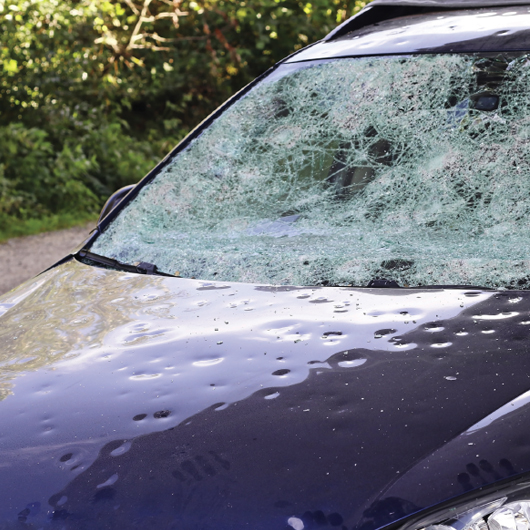A guide for agents and brokers
on the peril, its impact, mitigation steps and response
By Thomas Brocksmith
As natural catastrophes go, hail probably isn’t at the top of the list of perils that keep most people up at night. Yet, every year, hail is the cause of damage to hundreds of thousands of properties across the United States. There were 6,962 hail events in 2023 alone and 4,436 in 2022, as reported by the Insurance Information Institute.
Research has shown that hailstorms are at the root of 50% to 80% of thunderstorm-related losses annually. In fact, insured losses exceeded $20 billion due to hail alone in 2022. Given these figures, it behooves insurance agents and brokers to help their insureds understand more about this distinctive risk.
What exactly is hail and where does it come from?
Hail develops in a thunderstorm when rising air lifts water droplets high into the atmosphere, where temperatures are below freezing. Before the resulting hailstones become too heavy to fall to the ground, the updraft pushes them up repeatedly, freezing more ice around them.
Barometric pressures and the length of time that the hail circulates above contribute to the size of the hail that eventually falls; the stronger the storm, the more powerful the updraft, resulting in larger hailstones.
As reported by The Weather Channel, hail’s impact is usually driven by the size of the stones:
- Quarter-sized hail one inch in diameter will cause damage to shingles.
- Golf ball-sized hail 1.75 inches across will dent vehicles.
- Hail that is the size of a baseball, or roughly 2.75 inches, smashes windshields.
- Softball-sized hail that is upwards of four inches across can create holes in roofs.

We do see a few of those softball-sized hailstorms every year and they are remarkable. The largest recorded stone put them all to shame, however. In 2010, a hailstone measuring eight inches in diameter and weighing 1.94 pounds fell in Vivian, South Dakota. Fortunately, most storms are significantly less impactful!
What kind of damage can property owners expect from hail?
Swaths of hail are typically miles long, often with clearly defined perimeters. We frequently see hail go through half of a neighborhood with straight-line precision. In fact, it is not unheard of for half of a house to be damaged and the other half untouched.
Insurance policies are invoked for hail when there is accidental direct physical damage. This may include damage to roofs, mailboxes, air-conditioning condensers, gutters, window wraps, and other external elements.
Siding is a frequent casualty of hail; aluminum siding must be replaced once dented, often to the tune of thousands of dollars just for one house, and wooden siding can incur damage as well. Both the age of the siding and how it has previously been affected by elements can impact the extent of the damage.
Roofing materials can also suffer varying amounts of hail damage. Asphalt shingles, for example, are often prone to damage such as granule loss, cracking, or punctures. Metal roofs are generally more resilient, but dents and dings are still a possibility if the storm was severe enough. Commercial roofs with pitch and shingles can also be impacted, as can flat roofs with isometric rubber-like finish.
In addition to visible damage, hail weakens the structure of housing elements it strikes, making them more susceptible to future damage. Hail can reduce the life of roofing materials like shingles, asphalt, and tar as a result.
Another newer concern following a hailstorm is the presence and condition of solar panels. Even if the panels themselves do not sustain damage, if they are present on a roof that requires repair, we have to allow labor to remove and replace the panels.
Can anything be done in advance
to mitigate hailstorm losses?
Though hail is a challenging peril to prepare for and mitigate in advance, there are some things that property owners may want to consider.
A hail-resistant shingle is now available that is designed to withstand all but the most significant hailstones. Called 40–50-year shingles, these thicker shingles are very expensive, but insurance carriers will give property owners who install them a discount on their policies to help offset the cost. Note that even these shingles can get damaged in the event of hailstones that are softball-sized or larger.
Beyond impact-resistant roofing materials, there isn’t a whole lot that property owners can do to mitigate the risk of hail damage, besides ensuring that they have a good insurance policy in place.
How should property owners proceed if hail damage is incurred?
From an insurance adjuster’s perspective, hail is probably the easiest peril to assess in terms of damage because every house in the radius of the storm will experience the same kind of damage to shingles, gutters, etc. This can streamline the process of evaluating and pricing claims.
The good news is that hail does not typically cause enough damage to displace people who live or work in an affected building. It does, however, still need to be addressed in a timely fashion.
Most people don’t get on their roofs, so it can be challenging to tell whether or to what extent damage exists. As a result, property owners will often file a claim simply assuming damage because their neighbors have experienced a loss.
Once a claim is filed, an adjuster will call for information about the nature and scope of the loss; following the first notice of loss, the adjuster will come out to inspect the property. A good adjuster will inspect houses the same way every time, after which they will discuss their findings with the insured.
It’s not uncommon for contractors looking for work to knock on doors following a hailstorm offering to inspect the roof for damage. While it’s not a bad idea to find out what condition your roof is in, it is advisable to hire local, well-respected roofers or contractors to confirm damage. Policyholders frequently turn to their local insurance agent to see if they can recommend professionals for this task. If it’s not against your firm’s policy to provide referrals, it can be good to have some names on file to pass along.
The importance of informing
clients
As with all CAT perils, simply knowing what to expect from hail can help insureds know how to respond in the event of an incident.
This is my 19th year in the adjusting business and I’ve seen the frequency and severity of hailstorms ebb and flow several times over that period. The Central and South-Central region of the country are historically the most impacted
Because of the unpredictable and
widespread nature of hail, most insureds
have likely never experienced hail damage before.
Adjusters can be a great resource to first-timers.
(Texas and Nebraska experienced the largest number of hail events in 2023), but it can hail anywhere, and I’ve noticed that hail patterns seem to be shifting farther east in recent years.
Because of the unpredictable and widespread nature of hail, most insureds have likely never experienced hail damage before. Adjusters can be a great resource to first-timers.
We are always happy to help people understand how the age and condition of their roof impact the decision whether to repair or replace, what it means to get a property back to pre-condition loss, or how their deductible works.
Just like agents and brokers, our job is to deliver great customer service, and we are glad to take the time to explain anything that your clients don’t fully understand.
The author
Thomas Brocksmith is vice president of catastrophe operations at Crawford & Company.






